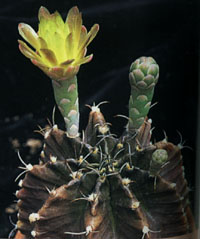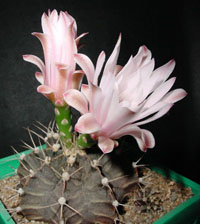Articles
A Disputable Question
 |
| Фото 1. Gymnocalycium mihanovichii (CACTUS HAND BOOK T.SATO). |
From the compiler. In the first issue of "CULTIVAR" we gave a footnote by Z.A.Mikhaltsev (Omsk, Russia), biologist who studies colored forms. It concerned the name Gymnocalycium mihanovichii v friedrichii. "Practically all the Gymnocalycium that refer to combination Gymnocalycium mihanovichii v friedrichii have been called Gymnocalycium friedrichii since long ago. It is a separate species."
In response we received an objection from another biologist – Nicolay Shemorakov: "There is no unified opinion. It is right to say both Gymnocalycium friedrichii and Gymnocalycium mihanovichii v friedrichii, as well as Gymnocalycium mihanovichii v pirraretaense and Gymnocalycium friedrichii v pirraretaense. They are synonyms. It is "fashionable" now to abolish old classifications and create new ones. But it means nothing yet. For instance, I like (and many cactophiles do) Kurt Bakeberg's classification and I use it. Others prefer Fred Katterman's system. Let them use it. It's quite another matter, as a famous Russian scientist Georgiy Volskiy said: "Don't put foolish ideas into your head. The point is not to become confused and not to confuse others". Each new classification should be approved by the world society and then it will adapt and replace other systems of classification. This process takes time".
Here is an opinion spoken out by Dmitriy Rogatskin (Smolensk), expert on Gymnocalycium.
 |
| Фото 2. Gymn. friedrichii (G. mihanovichii v.friedrichii), A. Mikhaltsev |
Almost everyone who has ever grown cacti had had a colored form commonly named as G mihanovichii v. friedrichii f. rubra. This name is wrong by a number of points. Not touching upon taxonimic peculiarities of colored forms names I should say that combination G mihanovichii v. Friedrichii is considered invalid (Parout, Friciana, 1964; Schutz. Monogr. Gen. Gynn., 1985; Pilbeam, G. - Col.G, 1995). The valid name is G. friedrichii. Besides, most varieties of G. Mihanovichii now refer to G. Friedrichii and 99% of all the colored forms of this taxon origin from it too. I have some suppositions why the situation is like this. However, not all the specialists admit the independence of Gymnocalycium friedrichii. They don't believe the Pageout-Schutz combination to be valid. The issue is still under question. Anyway, Gymnocalycium friedrichii is more than a variety.
The colored forms of Gymnocalycium referring to subgenera Microsemineum, Pirisemineum and Ovatisemineum are rarely to be found and mentioned. At least, not oftener than any other cacti. The representatives of Macrosemineum (G. denudatum) and Trichomosemineum (G. ragonesii and so on) are better known. Subgenus Muscosemineum is an absolute champion. It turns out that colored forms are more often formed by the oldest from the point of view of evolution subgenus (Macro-) and two youngest (Trichomo- и Musco-). The same subgenera also form crested and monstrous forms most often. At least I watched crested-monstrous G. Mihanovichii and crested G. Riojense appearing in my collection. Not going into detail (it will be interesting only to specialist and Gymnocalycium fans) one can say that there are 2 main branches in subgenus Muscosemineum: mountain Argentine species close to G. schiekendantzii (G. pungens, G. michoga, G. stuckertii and others) and chakoa species close to G. megatae и G. mihanovichii. In the early version of B.Schutz's classification there were a separate section for plants with apical flowers where G. mihanovichii, G. friedrichii, G. damsii and G. Anisitsii were included.
Subgenus Muscosemineum is the most detached. It does not have transitional forms to any other subgenus. The 4 mentioned species are considered the youngest and advanced in terms of evolution (which you can't say of the Argentine plants of the subgenus).
G. mihanovichii grows in the North-West of Paraguay, on the border of Eastern and Western Chako, within a radius of 100 km around Philadelphia. The natural habitat of G. Friedrichii crosses that of G. Mihanovichii, but mainly is located more to the North, in the Western Chako, in a more severe climate. This place is a rarely inhabited hilly plain with thick bush, hard to get through. It is the hottest spot of the continent in summer. The temperature may rise up to 47 (С. It rains hard for several months successively. Rivers overflow the banks and flood everything around for dozens kilometers. Some plants stay under water for some time. By the autumn the rains stop, and the water starts evaporating. The lowlands turn into salty marshes. In winter drought starts and Western Chako turns into a real semi-desert – leaves fall, grass burns out, rivers and marshes dry up and get covered with salty cracked crust. The pressure rises, the temperature falls (not lower than 10 (С). G. friedrichii and a number of other species live in those extreme conditions. As you probably know, regular exposure of living tissue to different stresses is a mutagen factor leading on one hand to the growth of resistibility, but on the other hand – to lethal mutations lying in the basis of colored forms. If we take into consideration that G. Friedrichii is a young, actively progressing taxon with lots of local forms having a very short period of vegetation in its homeland (spring), characterized by a very quick growth and early maturing tissues, and having, in any conditions, the most stable pigmentation of epidermis, there is nothing to be surprised at. However, this is just a hypothesis.
(On the other hand, the species from Chako province form hybrids easily, and the frequency of mutations is higher with hybrids – both cultural and natural. Though it is clear from the described examples that the proportion is equal – three hybrids against three "brend" ones. However, the sample is not large and is unlikely to be significant.)
Gert J.A. Neuhuber
Dear Mr. Kalishev,
sorry there is not much time to answer to your questions for I am going in three weeks to Argentine for about 2 months but I will try to answer to the most important things.
First of all G. friedrichii is a good species. G. anisitsii from southern Bolivia is a good species with var. damsii growing near Roboreto.
Today there a lot more colored plants known from the subgeneras Microsemineum and Gymnocalycium than from Muscosemineum which was only a interesting subgenera for the Czechians and maybe the Russians. But if color is a remarkable thing in evolution is still discussed.
Dimitry Rogatskin with whom I am in contact says there are 2 main branches in Musco
a) Argentine mountain species:
aa) G. pungens = not valid and until now not found again but surely not from the mountains.
bb) G. michoga = is not valid decribed and belongs to G. mihanovichii
cc) G. stuckertii = sensu Kiesling is a plant from San Luis, subgenera Gymnocalycium; for me a plant not to identify because it's pure description and photo. No information about seedgroup and spreading over provinces from Cуrdoba to Salta - nobody is in the position to say what's G. stuckertii.
b) chacoense species:
aa) G. mihanovichii and var. pirarettaense
bb) G. megatae is growing on top of low hills but it's forms (onychacanthum, tudae and eytianum in Bolivia) grow in in the flat.
They all have nothing to do with G. schickendantzii or G. delaetii. Only G. marsoneri (synonym G. knebelii) from Salta, Argentine has rootes to Bolivia.
In May 2001 H. Till (GYMNOCALYCIUM 14(2) 2001) published a new division of Gymnocalycium in which our friend Dimitry could see that there are transitional forms of Musco to other subgenus (If you carefully clean a Musco-seed from it's light brown cuticle you will have a Microsemineum-seed).
I hope I could help you, mit freundlichen Grьssen,
Gert J.A. Neuhuber h.neuhuber@mail.asn-linz.ac.at
Traunaustr. 4/10 A-4600 WELS http://home.eduhi.at/cometo/gymnoneuhuber
Translation Irina Koudina (Okounkova , Mosсow, Russia, e-mail: irinkos2@yandex.ru)





